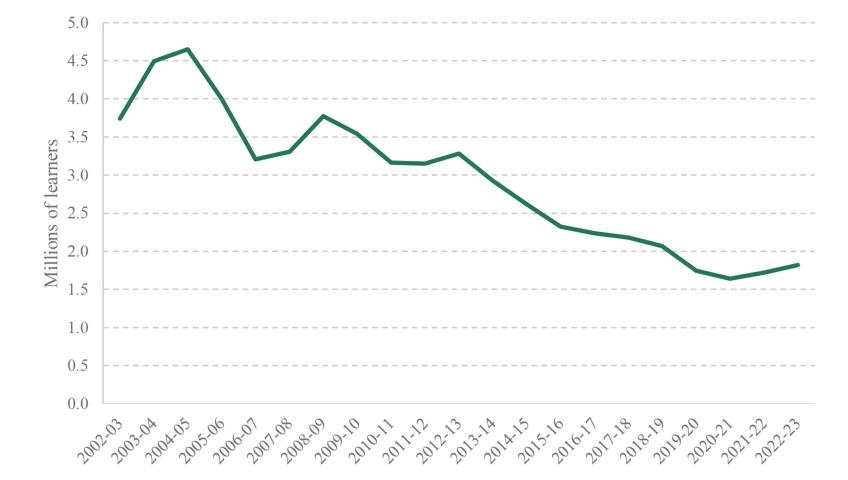The Labour Party has today recommitted to its plan to broaden the existing Apprenticeship Levy into a ‘Growth and Skills’ Levy, allowing firms to use up to 50% of their levy contributions to fund training through routes other than apprenticeships.
This would increase the flexibility that employers have to fund training and bring England in line with the rest of the UK and most other comparable countries (where training subsidies dedicated specifically to funding apprenticeships are uncommon). However, greater flexibility might also increase the risk that funding is used for courses that employers would have offered (and paid for) anyway, or for lower-value courses. Labour plans to address this with a list of approved non-apprenticeship training courses that the levy could fund. But determining high-value courses is easier said than done and would be a key factor in determining the success of this policy were it put into practice.
A backdrop of falling training levels
The proposal comes against a backdrop of steep falls in training. Average employer spending on training has fallen by 27% in real terms since 2011, and public spending on adult education and skills is down by 31% over the same period. As Figure 1 shows, the number of adults on further education courses has declined by about 50% since 2010, from about 3.5 million in 2010 to 1.8 million in 2023.
Figure 1. Total number of adult learners (aged 19+) taking publicly funded adult educational qualifications in England

Source: Learner numbers from 2002–03 to 2018–19 from Figure 2.2 in Sibieta, Tahir and Waltmann (2021). Learner numbers for 2019–20 to 2022–23 calculated from Department for Education apprenticeship statistics and adult further education participation statistics.
Greater flexibility for firms - but higher potential for deadweight costs
The Apprenticeship Levy currently raises around £3.5 billion a year from large employers in the UK. Firms have first dibs on these funds, but can only use them to pay for apprenticeships. The subsidy covers the full training costs for levy-paying firms and 95% of training costs for non-levy-paying employers. Despite these large subsidies, around £550 million of the total levy pot is not used to subsidise apprenticeships.
Labour’s proposal for a ‘Growth and Skills Levy’ would give firms in England additional flexibility to use up to half of their levy contributions for specified forms of non-apprenticeship training. In principle, this could help employers to pay for other forms of training that they and their employees would find valuable. But the history of these wider training subsidies, such as the former Train to Gain programme, suggests that the result is often that much of the spending goes on training that firms would have provided - and paid for - even without the subsidy.
(Re-)introducing traineeships
Labour has singled out traineeships as a particular priority. These basic skills programmes, which combine work preparation training, English and maths, were introduced in 2013 but then scrapped by the current government last year.
Under the costings that Labour sets out, around 3% of the Apprenticeship Levy pot (or just over £100 million a year) would fund around 150,000 traineeships. This implies a cost of around £750 per traineeship, which is roughly in line with the cost of a single functional skills qualification. A broader programme combining English and maths courses plus a work preparation course would cost around five times as much.
Is this really all about young people?
Labour is pitching these reforms as part of its ‘Youth Guarantee’ for 18- to 21-year-olds. But, at least under the current design of the Apprenticeship Levy, firms would be able to spend the funds on employees of any age. Currently, just under half of all apprenticeships are taken up by employees aged 25 or over.












